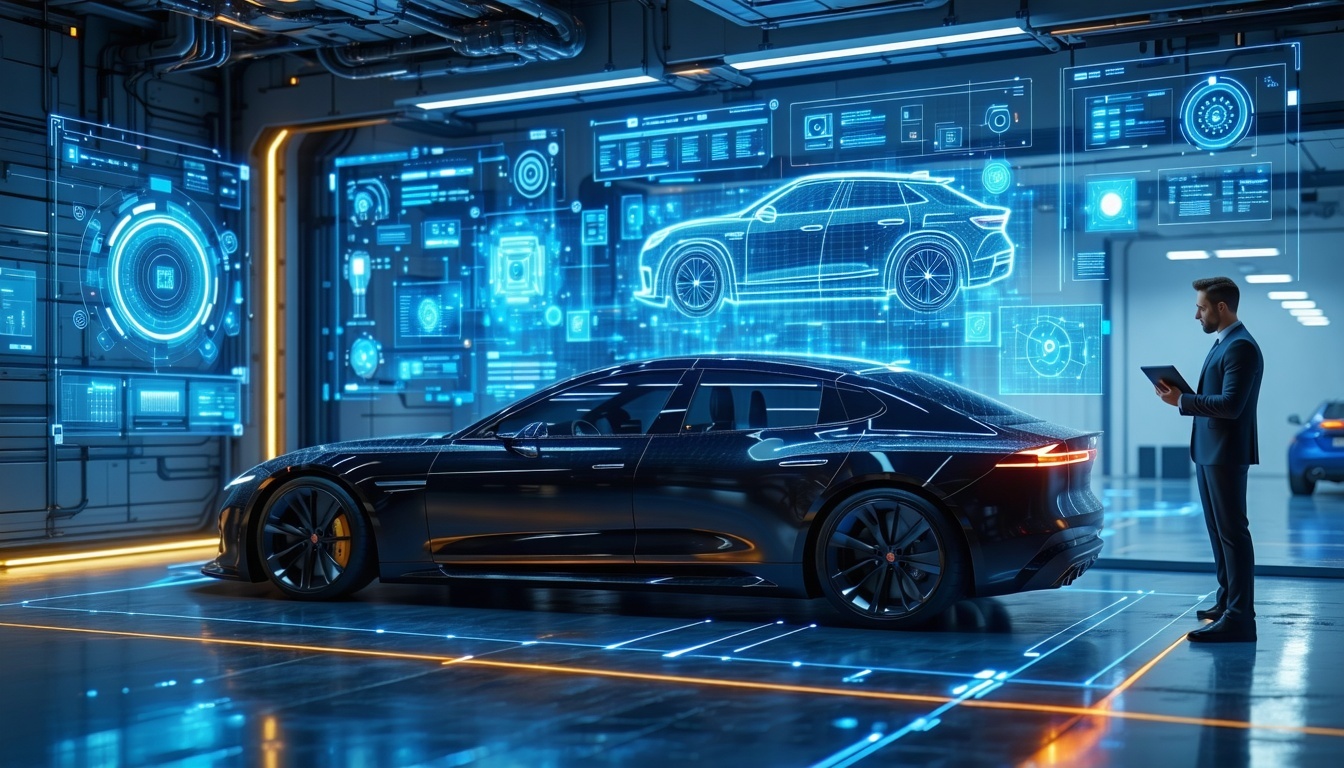A New Intersection of AI and Automobiles
Imagine a car that not only tells you something’s wrong, but figures out what to do about it and takes action. This isn’t science fiction; it’s an emerging reality at the convergence of generative AI, agentic AI, and the connected automotive world. Modern cars are packed with sensors and always-online connectivity, churning out data on everything from engine health to tire pressure. Traditionally, a “Check Engine” light or a low-tire warning leaves the driver to decide what’s next. But with agentic AI (autonomous AI agents) on the rise, that data can fuel AI-driven agents that diagnose issues and kick off repairs automatically. For example, one prototype system envisions the car detecting an engine anomaly and immediately contacting the driver’s preferred service center, scheduling an appointment, and even pre-ordering replacement parts, all without human intervention. In essence, your car shifts from merely blinking warnings to orchestrating its own care.
This leap is powered in part by generative AI technologies under the hood of these agents. Large language models (think of the brains behind ChatGPT) give the agent the ability to interpret complex information and communicate decisions in natural language. The agent can reason about the severity of a problem and propose an action plan as a savvy mechanic would. As one industry expert put it, these AI agents essentially “turn insight into action without a human in the loop,” operating 24/7 at scale to address issues as soon as they’re detected. The result is a proactive approach to car maintenance that could minimize breakdowns and downtime.
From Data to Action: Agentic AI in the Driver’s Seat
The concept of agentic AI goes beyond static automation, it’s about AI systems having the agency to make decisions and perform multi-step tasks on their own. In the automotive context, this means an AI agent doesn’t just flag that your oil is low; it handles the whole process of fixing it. Consider a scenario many of us have faced: a warning light flashes on during your commute. Instead of leaving you guessing how urgent it is, an agentic AI could instantly evaluate sensor readings to determine the issue’s severity, inform you in plain language, suggest the best course of action, and then carry it out, say, by booking a service appointment at a nearby garage that has the right slot and even ordering an oil change kit in advance. All you did was acknowledge the prompt, and your “virtual mechanic” took care of the logistics.
Crucially, this agent behaves intelligently and autonomously. It can cross-reference your vehicle’s diagnostics with maintenance histories, interpret any error codes, and even negotiate the scheduling based on your calendar preferences. Such capability draws on generative AI’s strength in understanding context and generating appropriate responses (e.g. contacting the service center with a clear description of the problem) while leveraging the structured logic of automation for execution. The convergence of these technologies effectively gives the car a “concierge” for maintenance and support. No wonder Gartner has spotlighted agentic AI as a top strategic technology trend for enterprises in 2025, it unlocks possibilities well beyond what traditional chatbots or isolated IoT alerts could do.
And it’s not just a far-off idea. Drivers themselves are eager for this kind of AI assistance. A recent survey found that 70% of drivers want an AI agent to actively diagnose and resolve car issues in real time, and 80% want an agent to proactively alert them about mechanical problems. In other words, the majority of consumers seem ready to trust an intelligent co-pilot for vehicle upkeep.
Consumer interest in AI-powered car maintenance is high. In one survey, 70% of drivers wanted an AI agent to diagnose and fix issues in real time, and 80% wanted an agent to proactively alert them to mechanical problems.
This strong interest is likely driven by the promise of convenience and peace of mind. An AI agent that catches a failing battery before it dies or schedules brake service before you even notice the pads are low can save drivers time, money, and hassle. Early trials in the industry hint at these benefits. Automakers and tech companies are piloting systems for predictive maintenance, where the AI anticipates needs and handles them seamlessly. The endgame is a fundamentally improved ownership experience: vehicles that maintain themselves (with a little help from digital assistants) so that owners can focus on driving rather than repair logistics.
Generative Brains + Low-Code Muscle
What’s making this new wave possible now? A big factor is the maturation of generative AI and low-code platforms in the enterprise, which provide both the “brains” and the “muscle” for agentic systems. The “brain” comes from generative AI models that excel at language understanding and decision reasoning. These models can ingest a car’s diagnostics or a trove of service manuals and converse about them, explaining issues to users or querying knowledge bases for solutions. They enable the AI agent to interact naturally with humans (e.g. reassuring a driver that the tire pressure drop is minor and help is on the way) and to make sense of unstructured data. Notably, car manufacturers have started to integrate such generative AI into vehicles’ user interfaces. For instance, Mercedes-Benz recently rolled out an update that integrates OpenAI’s ChatGPT into the voice assistant of over three million vehicles, enabling more natural dialogue and on-demand answers for drivers. While that system is focused on answering questions and enhancing in-car conversation, it lays the groundwork for more agentive features, the same AI that chats with you could next be coordinating your service appointment.
On the “muscle” side, low-code and no-code platforms are accelerating how these AI agent solutions are built and deployed, especially in B2B settings. In the past, creating an integrated AI-driven workflow, tying vehicle telematics, customer scheduling, inventory management, and messaging, would be a massive software project. Now, enterprise low-code platforms (like those from Microsoft, Salesforce, Mendix, etc.) are adding plug-and-play AI components that make it much simpler. They’ve already seen success by letting non-engineers drag-and-drop their way to business apps, and increasingly these platforms have gen AI assistants to help build apps or automate processes via natural language. It’s no surprise, then, that analysts report the number-one use case for these platforms is building AI-infused applications. In the context of automotive maintenance, this means an automaker or dealership could configure an AI agent workflow without starting from scratch, connecting a car’s data feed, a language model “assistant,” and a service scheduling system together through minimal code. One company’s no-code AI agent builder even allows teams to custom-train an agent on their knowledge base and policies, then deploy it across channels like chat, SMS, and email. Translate that to automotive, and a dealership’s agent could seamlessly interact with customers: over text message it might say, “Your car’s due for a check-up; I’ve penciled in an appointment on Friday and ordered the necessary parts, reply YES to confirm.”
This fusion of generative AI and low-code tooling essentially democratizes the creation of complex AI agents. It lowers the barrier for innovative mash-ups of capabilities, like a car maintenance agent that’s hooked into both the physical world (IoT sensor data) and digital services (maintenance databases, calendars, messaging). The agent can use its generative “brain” to adapt to a variety of inputs and scenarios, while the low-code infrastructure ensures it can securely plug into enterprise systems and follow business rules (like warranty policies or repair workflows). In short, generative AI provides the intelligence and flexibility, and low-code provides the integration and speed needed to bring agentic AI into everyday use.
Rethinking Car Care and What’s Next
The emergence of these AI-driven agents in automotive maintenance is a subtle but significant shift. It’s not as flashy as self-driving cars, yet it could profoundly change the day-to-day relationship we have with our vehicles. Instead of reactive care, waiting for something to break or a light to flash, maintenance becomes a continuous, proactive service. Your car becomes more like a living system that keeps itself healthy, with the AI agent as an ever-vigilant caretaker. For businesses, particularly automakers and dealerships, this convergence opens new models of customer service and loyalty. Imagine a brand that sells not just a car, but an intelligent maintenance concierge that comes built-in; the convenience and trust that builds could be a serious differentiator.
Of course, this is still an emerging development. It’s underreported in mainstream tech news, in part because it requires bridging several domains, automotive engineering, AI, and enterprise software, which don’t always intersect in the public eye. There are challenges to solve before your car hands itself over to an AI agent completely. Data privacy and security are paramount: vehicles generate sensitive data, and giving an agent access to act on that data (scheduling a service or ordering a part) means strict safeguards and permissions must be in place. Automakers will need to ensure these agents perform reliably and transparently, to build drivers’ confidence. There’s also the human factor: not everyone will immediately be comfortable with an autonomous system making decisions about their car. Clear communication (another strength of generative AI) will be key, the agent should keep the driver in the loop, explaining why it’s doing what it’s doing.
What’s exciting is that the pieces are rapidly falling into place. The vast majority of new cars being sold today are connected and software-defined, which provides the raw platform for AI upgrades. Meanwhile, enterprise AI is becoming “agentic,” able to not just chat but act. The convergence of these trends is yielding that esoteric yet powerful insight: your car can fix itself, or at least try to, when guided by a smart digital agent. It’s an innovation at the intersection of generative AI’s reasoning, agentic AI’s autonomy, low-code’s accessibility, and the automotive world’s connected revolution. For those in the know, it prompts fascinating questions. Will routine car maintenance someday be as hands-off as automatic software updates? How will mechanics’ roles evolve when an AI schedules most appointments and perhaps even pre-diagnoses issues? As this niche development gains momentum, it invites both optimism and debate. One thing is certain, the way we think about “car care” is on the cusp of a high-tech transformation, driven by a collaboration between engines and algorithms that many have yet to realize is even possible.
Readers familiar with AI and automotive tech might find this convergence a spark for further thought. It’s a reminder that often the most impactful innovations come not from a single technology in isolation, but from unexpected combinations. Today it’s an AI agent in the garage; tomorrow it might be new synergies we haven’t yet imagined. The agentic automobile is just the beginning, and it’s a development worth watching as it shifts gears from a curious experiment to a potential new normal in vehicle ownership.
Sources: The ideas and data discussed here draw on recent insights from industry experts and surveys, including Salesforce’s automotive AI findings salesforce.com, Sprinklr’s analysis of agentic AI use cases sprinklr.com, Gartner’s 2025 tech trend report sendbird.com, enterprise tech commentary in CIO cio.com, and real-world initiatives like Mercedes-Benz’s ChatGPT pilot neowin.net, among others, to illustrate this emerging intersection of generative AI, agentic AI, low-code platforms, and the automotive domain.



